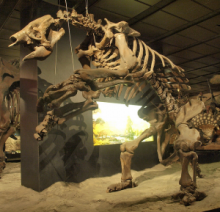Article
Sloths are two- or three-toed mammals related to anteaters. Sloths today tend to be arboreal, living in trees above the forest floor, and are very slow moving.
Ground sloths are the extinct predecessors of today's sloths. However, ground sloths tended to be very large in size, often as large as elephants; they were formibidable animals to hunt because of their size and their large digging claws, and they were not as slow-moving as today's smaller, arboreal versions. Populous throughout the Americas, ground sloths disappeared from the continental mainland about 10,000 years ago at the end of the Pleistocene era. This die-off is associated with climate change and human activity, specifically hunting, as ground sloth populations disappeared about 4,000 years ago on islands in the Caribbean, about the time when humans reached these areas in significant numbers. The last living ground sloths in North America are theorized to have lived in the region that is now New Mexico.
"Fossilized skeletal remains of a giant ground sloth found near Daytona Beach, Florida" by donvega.
Manuscripts
References
Kurtén, Björn, and Elain Anderson
1980 Pleistocene Mammals of North America. New York: Columbia University Press.
Steadman, David W., Paul S. Martin, Ross D. E. MacPhee, A. J. T. Jull, H. Gregory McDonald, Charles A. Woods, et al
2005 Asynchronous Extinction of Late Quaternary Sloths on Continents and Islands. PNAS 102(33): 11763–11768.

